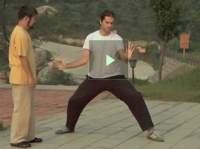Kua exercise: 1. Use front kua to draw the circle. Upper body and arms are locked in position, one piece, no move, only use and exaggerate kua movement. You can fold forward and lean back, feet can move to make it even bigger. 2. Use back kua as a hinge/pivot. Front knee can be lifted, lock upper body, arms and front leg as one piece, tight, hinge from the back kua.
All the moves in Chen Style Taijiquan are designed to make your opponent fall onto the back of the head hitting a rock.
In push hands, you are caught, you are losing so much, the body is so locked and stiff, there is nothing else you can do, you can only rotate. Lean back- locked/cornered-rotate. When you are dead cornered, you convert it into a different dimension. One move converts to another. We are always making moves. While doing the forms, all the moves you make, you are not allowed to. Sunzi, art of war, being pushed-adapt-full extreme-turn it sideways-becomes an attack. At the end of his cycle, you start your cycle. Straight move/line to horizontal move, is a spiral, is a conversion. At the end you add another dimension. A flat circle, you add depth to it, stretched out circle. No seam天衣无缝. Linear to rotation. When you lean back so much, your lower back will hurt, which opens the tailbone. Yin and yang is the ball bearing. Three parts doing its own things independently at the same time. Firm structure. Movements do not contribute to the structure. 1. Rubber band, two ends are fixed, middle can move/swing. 摇把. 2. Wheels are pivots. Lock the inside, move outside.
Proportional moves are gained through training. It is a process. If the moves are proportional at the beginning, it is doing the moves(faking the moves). It does not have the quality of stiffness/structure. At the beginning, we must lock the body parts into pieces and only move the joints. Then the smoothness you achieve later is strong, has a structure.
My correction. Second section. My stance is too big that my structure is collapsing. It pulled my other parts out of position, head, central axis, front kua.


